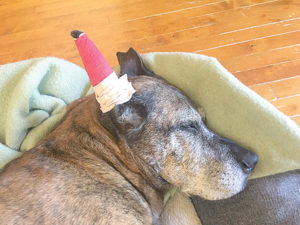By Mia Glass
When Amy Kresloff discovered another ear hematoma on her 14-year-old dog Brisket, she knew they needed to see a veterinarian. But how to do that safely during a pandemic?
“She had had one several months ago in her left ear and it ended up needing surgery to correct. When this one ballooned quickly I wanted it taken care of as soon as possible,” Kresloff said.
As the COVID-19 pandemic continues, veterinary hospitals across the nation are changing the way they run their practices so patients like Brisket can receive the care they need. Brisket was able to be seen by a doctor at the Red Bank Veterinary Hospital (RBVH), in Tinton Falls under their new curbside system.
The new guidelines are simple: Kresloff followed the signs at the hospital and pulled into a parking space. After checking in with a phone call, a technician came out to get Brisket from the car. The doctor examined Brisket, then called Kresloff to discuss options for the dog’s care. After coming up with a plan, Brisket was ready to head home.
“We use the CDC guidelines, the WHO guidelines, the AVMA, and the NJVMA to help us,” said Stacy Burdick, chief of staff at RBVH, a member of the Compassion-First Pet Hospitals national network. “All of those hospitals adapted very similar policies to stay in line with what all these bodies are recommending,” Burdick said.

When Amy Kresloff’s dog Brisket needed veterinary care during the COVID-19 pandemic, she was able to take advantage of new procedures for animal health care, including curbside drop-off and electronic document signing.
Staff members wear appropriate personal protective equipment based on the answers to screening questions given to clients beforehand. Inside of the hospital, staff must wear masks and social distance at all times. Cleaning protocols have been completely revamped according to the CDC guidelines as well.
With veterinary hospitals still running, many people are left wondering whether pets can spread the virus. At the present time, the general consensus is that pets do not directly transfer the disease, but could potentially carry it on their fur.
“It’s very difficult because how do you prove that, right? Just to be cautious and extra safe, if they (the animals) are coming from a positive household, we bring them to a separate part of the hospital and wipe them down and bathe them before introducing them into the general population,” said Burdick.
Many clients also enjoy Air vet, a new telehealth app implemented by the hospital. This allows pet owners to video chat with a doctor to determine a course of treatment which may avoid a trip to the hospital. At RBVH, the nutritionist on staff was able to go completely virtual, only taking Air vet appointments. She is going back to the hospital this month, but will continue to offer virtual appointments as well.
The hospital has remained open since the pandemic hit and clients are appreciative of each doctor’s commitment to taking care of their pets no matter the circumstances. There was even a parade of thanks by the local police and fire departments, bringing tears of joy to many staff members’ eyes.
“We were getting food, cookies, cake anything you could think of was being delivered to the hospital on a daily basis just saying thank you for being there. It was really heart- warming,” said Burdick.
With doctors resuming physical examinations and the number of appointments increasing in the past weeks, the hospital is discussing ways in which it could reopen to pet owners and not just their pets in the future. Large plexiglass guards are already being installed in the lobby to ensure safety when the hospital does decide to let its human clients in the building again.
“We just need to make sure that it’s done correctly with all of our staff’s safety as top priority,” said Burdick.
Many of the new procedures that came about as a result of the coronavirus may end up becoming permanent practice for the convenience of the clients, especially those who are elderly or immunocompromised. However, there are definitely factors to consider, such as the pollution from running cars while owners wait in the parking lot or some pets’ inherent need for emotional support from their owners during exams.
“While it was fine to just speak to the doctor by phone in this case, I am not sure it would be ideal most of the time,” said Kresloff.
As the hospital considers future plans, Burdick cannot help but reflect on the perseverance and endurance of all the staff members who were thrown into the challenges that came with being essential workers during a pandemic.
“It’s just incredibly humbling and makes me really proud of every one of our employees for what they’ve done and what they’ve accomplished over the past couple of months,” Burdick said.
TIPS FROM THE VET
• Social distancing your pets is more for the owner than the pet, so it’s best to avoid dog parks and exercise on trails instead.
• Unless your pet is very overdue for a routine visit, do not go into the hospital for non emergency situations.
• If your pet has any health issues, call your veterinarian first to see if it is something that can be handled at home, via telehealth or, as a last resort, requires a hospital visit.
• Do not change your pet’s diet right now. Changes in diet may lead to gastrointestinal emergencies that could mean a trip to the veterinarian.
• During the upcoming summer weather, make sure to walk your pet safely to avoid heat-related emergencies.
• For people returning to work who have been home for with their pets for months, make sure to return to a routine exercise schedule and spend extra time with them on week- ends.
The article originally appeared in the June 18-24, 2020 print edition of The Two River Times.














